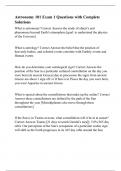Astronomy 101 exam 1 - Study guides, Class notes & Summaries
Looking for the best study guides, study notes and summaries about Astronomy 101 exam 1? On this page you'll find 16 study documents about Astronomy 101 exam 1.
All 16 results
Sort by
Astronomy 101 Exam 1 Questions with Complete Solutions
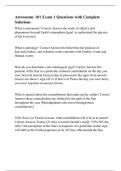
-
Astronomy 101 Exam 1 Questions with Complete Solutions
- Exam (elaborations) • 11 pages • 2024
-
- $15.49
- + learn more
What is astronomy? Correct Answer-the study of object's and phenomena beyond Earth's atmosphere [goal: to understand the physics of the Universe] What is astrology? Correct Answer-the belief that the position of heavenly bodies, and celestial events correlate with Earthly events and Human events How do you determine your astrological sign? Correct Answer-the position of the Sun in a particular zodiacal constellation on the day you were born [in ancient Greece] due to procession the signs...
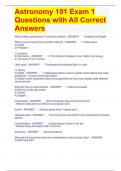
-
Astronomy 101 Exam 1 Questions with All Correct Answers
- Exam (elaborations) • 19 pages • 2023
-
Available in package deal
-
- $13.29
- + learn more
Astronomy 101 Exam 1 Questions with All Correct Answers What makes a good theory? (scientific method) - ANSWER Testable and Simple What is the process of the scientific method? - ANSWER 1) Observation 2) Model 3) Prediction 1) Universe 2) Astronomy - ANSWER 1) The totality of all space, time, matter, and energy 2) The study of the universe Light years - ANSWER The distance travelled by light in a year 1) Theory 2) Model - ANSWER 1) Ideas/assu...
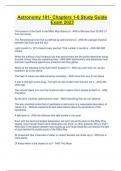
-
Astronomy 101- Chapters 1-6 Study Guide Exam 2023
- Exam (elaborations) • 9 pages • 2023
-
- $12.49
- + learn more
Astronomy 101- Chapters 1-6 Study Guide Exam 2023 The location of the Earth in the Milky Way Galaxy is - ANS-a little less than 30,000 LY from the center The Astronomical Unit (AU) as defined by astronomers is - ANS-the average distance between the Earth and the Sun Light travels 3 x 10^5 meters every second. That number in words is - ANS-300,000 meters When the authors of our textbook say that astronomers are like police detectives trying to solve crimes, they are explaining that: ...
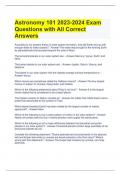
-
Astronomy 101 2023-2024 Exam Questions with All Correct Answers
- Exam (elaborations) • 23 pages • 2023
-
Available in package deal
-
- $13.99
- + learn more
Astronomy 101 2023-2024 Exam Questions with All Correct Answers According to our present theory of solar system formation, how did Earth end up with enough water to make oceans? - Answer-The water was brought to the forming Earth by planetesimals that accreted beyond the orbit of Mars. The terrestrial planets in our solar system are: - Answer-Mercury, Venus, Earth, and Mars. The jovian planets in our solar system are: - Answer-Jupiter, Saturn, Uranus, and Neptune. The planet in our so...

-
ASTRONOMY 101 FINAL EXAM QUESTIONS WITH CORRECT ANSWERS
- Exam (elaborations) • 42 pages • 2023
-
Available in package deal
-
- $13.59
- + learn more
ASTRONOMY 101 FINAL EXAM QUESTIONS WITH CORRECT ANSWERS 1. What is the main mechanism by which the lower atmosphere of Earth is heated? a. Sunlight heats Earth's surface and the resultant heat is transferred to the atmosphere by infrared radiation and convective gas motions. b. Conduction carries heat from Earth's interior to the surface where conduction in the lower atmosphere transfers this heat to the higher layers. c. friction between the winds in the atmosphere and the mounta...
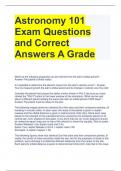
-
Astronomy 101 Exam Questions and Correct Answers A Grade
- Exam (elaborations) • 4 pages • 2023
-
Available in package deal
-
- $11.99
- + learn more
Astronomy 101 Exam Questions and Correct Answers A Grade Which of the following properties can be inferred from the star's orbital period? - Answer-The planet's orbital radius Is it possible to determine the planet's mass from the star's velocity curve? - Answer-Yes, by measuring both the star's orbital period and its change in velocity over the orbit Consider the planet that causes the stellar motion shown in Plot 2 (be sure you have clicked the "Plot 2" button in the lower windo...
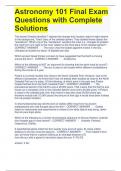
-
Astronomy 101 Final Exam Questions with Complete Solutions
- Exam (elaborations) • 8 pages • 2023
-
Available in package deal
-
- $12.89
- + learn more
Astronomy 101 Final Exam Questions with Complete Solutions The ancient Greeks identified 7 objects that change their location night-to-night relative to the background, "fixed" stars of the celestial sphere. They dubbed these objects the "wanderers". Which one of the "wanderers" wanders the most (i.e., changes its position the most from one night to the next) relative to the fixed stars of the celestial sphere? - CORRECT ANSWER The moon (has the fastest apparent motion in the sky,...
Astronomy 101 Exam 1 study guide Questions with Correct Answers. Astronomy 101 Exam 1 study guide Questions with Correct Answers.
Astronomy 101 Exam 1 Question and Verified Answers. Astronomy 101 Exam 1 Question and Verified Answers.

Study stress? For sellers on Stuvia, these are actually golden times. KA-CHING! Earn from your study resources too and start uploading now. Discover all about earning on Stuvia

